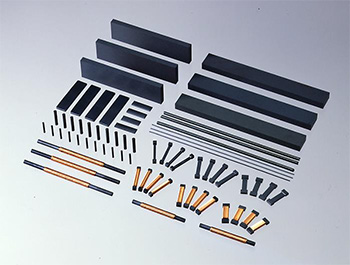Development of New High-Robustness Ni-Zn-Based
Soft Ferrite Material "ND57S"
December 21, 2017
Hitachi Metals, Ltd.
Hitachi Metals, Ltd. (hereinafter referred to as "Hitachi Metals") has developed a high-robustness*1 Ni-Zn-based soft ferrite material, ND57S, with improved resistance to external forces and temperature changes. ND57S will contribute to improving the functionality and safety of vehicles, whose components require characteristic stability (robustness) under more severe conditions than for general home appliances.
1. Background
Hitachi Metals produces and sells soft ferrite cores as soft magnetic materials for use in electronic circuits such as for automotive electronic components. Our soft ferrite cores are highly regarded for their stable quality and used by many customers.
Sensing and antenna components, which have been increasingly used in IoT technology in recent years, require characteristic stability (robustness) under severe conditions. Characteristics that resist stress and temperature changes are required of the soft ferrite core, which forms a coil as a key component of the technology. Particularly, soft ferrite cores for automotive applications (keyless entry systems and tire air pressure sensors) are used in severe conditions and require high stability in inductance*2 to withstand external stress during the plastic molding process and changes in operating temperature.
2. Performance

"ND57S"
The new Ni-Zn-based soft ferrite material, ND57S, developed by Hitachi Metals has made it possible to achieve, based on our unique technology, the optimization of the main constituents of ferrite, the miniaturization of the crystalline structure through the improvement of the baking process, and improvement of ability to withstand to external stress and temperature changes over the existing material.
When used as a core for an antenna for key entry systems and tire air pressure sensors, ND57S can contribute to achieving size reduction, high performance and high reliability.
With ND57S added to our product line, Hitachi Metals will accommodate customer needs for product design more extensively than before.
Hitachi Metals will continue to focus on the development of new materials and contribute to further increasing the efficiency and reliability of electronic components and reducing their size and weight.
■Features of ND57S (compared to Hitachi Metals' existing product "ND50S")
- 1Smaller change in inductance across a temperature range of -40 to 100℃
(Reference data: the relative temperature coefficient*3 (at a reference temperature of 20℃) has been reduced by about 50% at -40 and 100℃.) - 2Smaller change in inductance with temperature changes after the plastic molding process
(Reference data: the rate of change in inductance (at a reference temperature of 20℃) has been reduced to about 80% at -40℃ and about 40% at 100℃.)
3. Production Bases
Hitachi Ferrite Electronics, Ltd.;
Hitachi Metals Hong Kong Limited, Pan Yu Factory
4. Application
Core material for automotive antennas
5. Patent
Basic patent applications have been filed
For inquiries from customers:
Specialty Steel Company, Hitachi Metals, Ltd.
For inquiries from the press:
Corporate Communications, Hitachi Metals, Ltd.
hmcc.sa@hitachi-metals.com
Supplementary Explanations
| Shape of Standard Core | ND57S (Newly developed) |
ND50S (Our existing product) |
|
|---|---|---|---|
| Relative temperature coefficient: α µ ir Frequency: 100 kHz |
-40 to 20℃ | 1 x 10-6 | -2 x 10-6 |
| 20 to 100℃ | -1 x 10-6 | -2 x 10-6 | |
| Initial permeability: µi Frequency: 100 kHz |
570 | 500 | |
| Curie temperature*4 | 145℃ | 150℃ | |
| Core shape: 2 mm x 16 mm x 1 mm Windings: 0.23 mm in diameter/45 turns |
ND57S (Newly developed) |
ND50S (Our existing product) |
|
|---|---|---|---|
| Rate of change of inductance Frequency: 100 kHz |
-40 to 20℃ | 0.4% | 1.9% |
| 20 to 100℃ | -1.7% | -2.9% | |
Glossary
- *1Robustness: ability to internally resist changes in external factors such as stress and environment
- *2Inductance: measure of electromagnetic induction intensity and the constant of proportionality of the induced electromotive force to the rate of change of current
- *3Relative temperature coefficient: value obtained by dividing the change in permeability per degree of temperature change by the initial permeability
- *4Curie temperature: transition temperature at which a ferromagnetic material changes to a paramagnetic material or a ferroelectric material changes to a paraelectric material